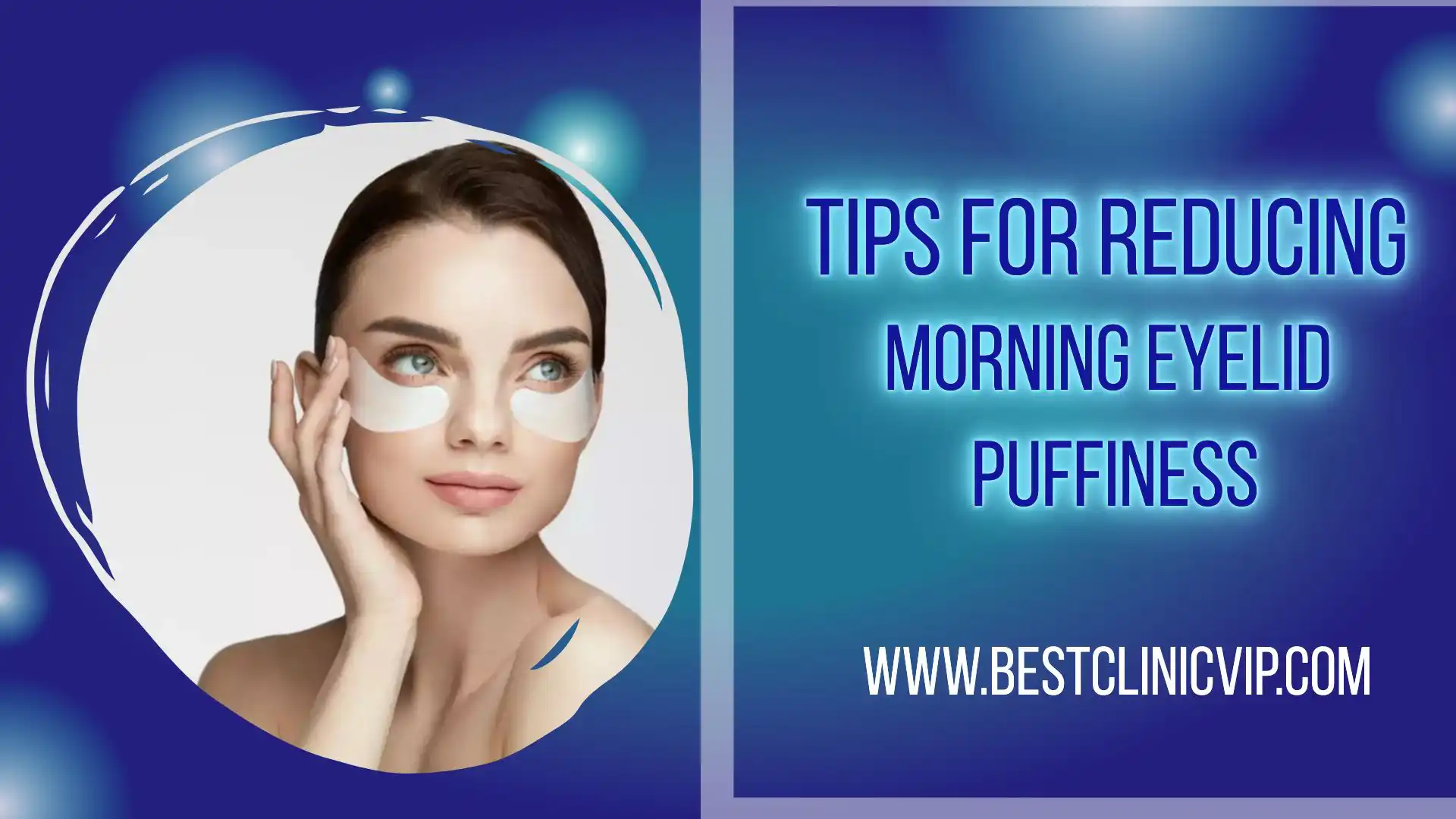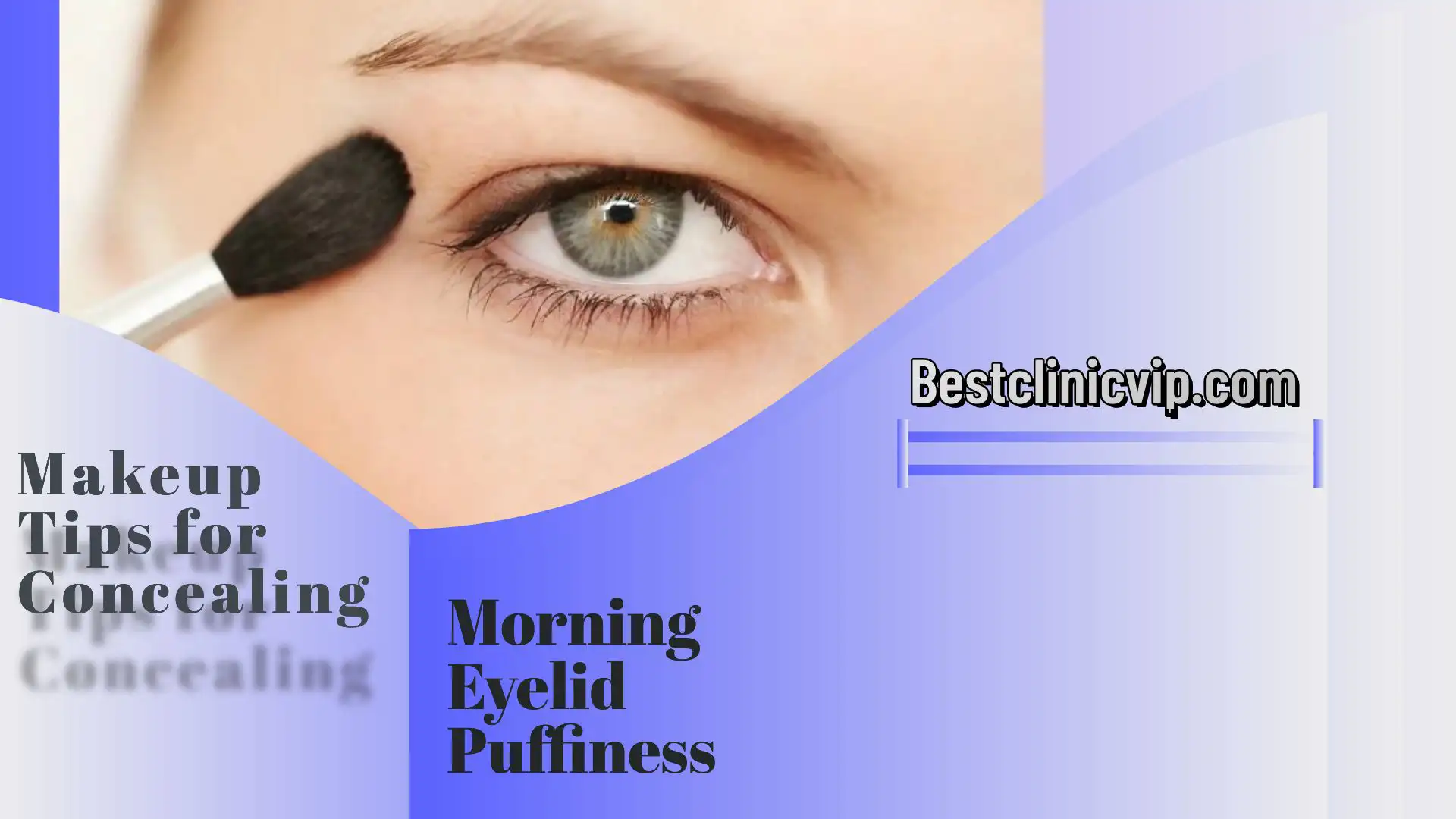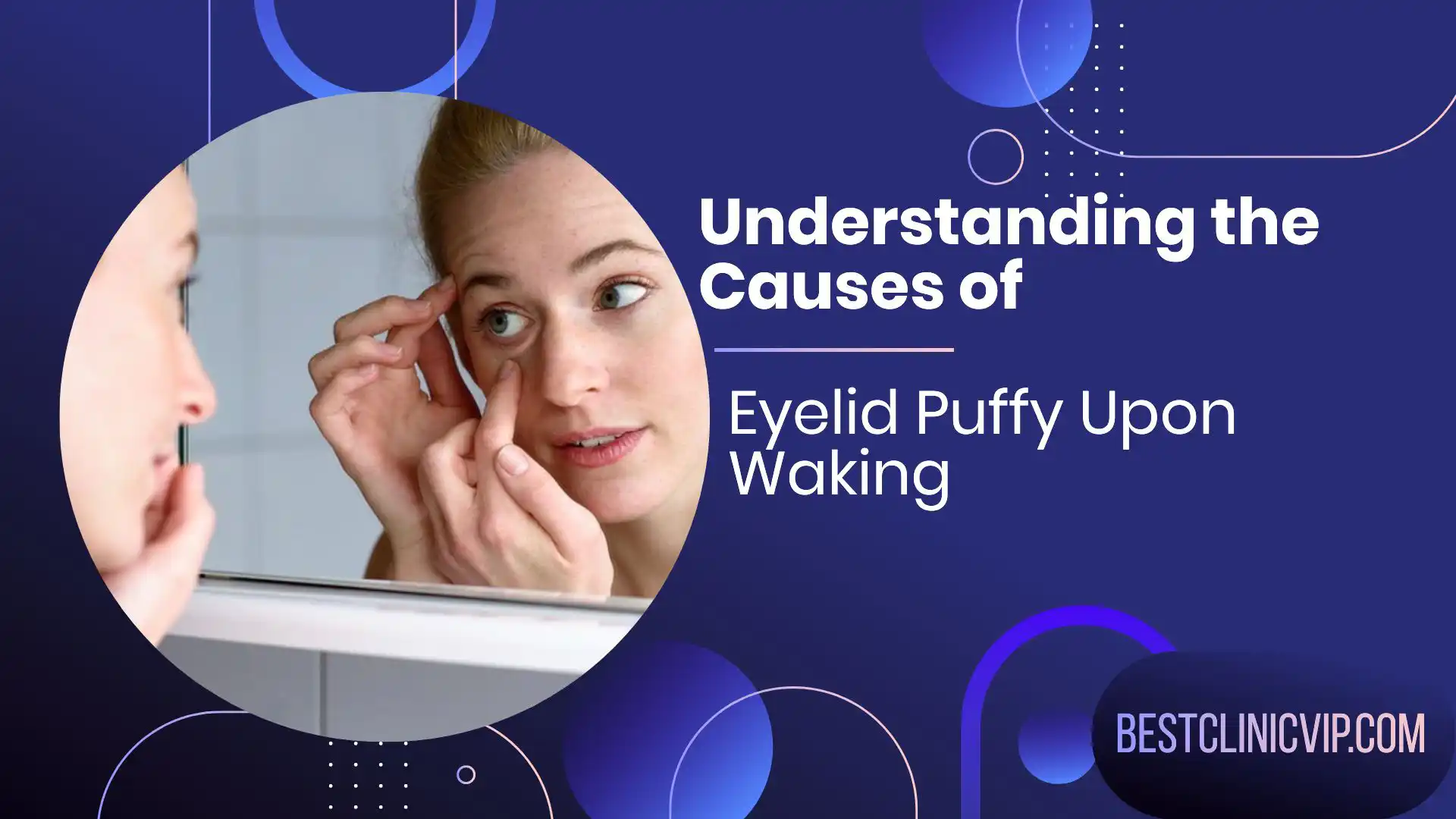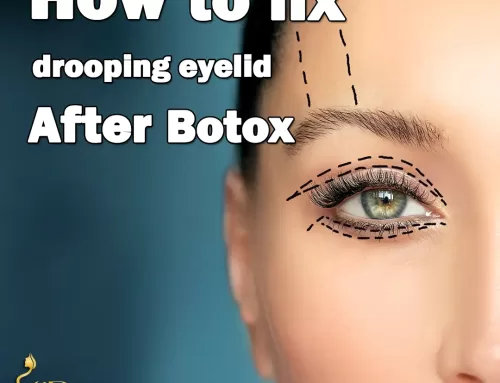There are several reasons why your eyelid may be puffy when you wake up in the morning. One of the most common reasons is fluid accumulation, which occurs due to the body’s position during sleep. When you lie down, the fluid that accumulates in the tissues around your eyes may not be able to drain properly, leading to puffiness.
Other factors that can cause morning eyelid puffy include allergies, which can cause inflammation and swelling, as well as sinusitis, which can also lead to fluid buildup in the face. In some cases, eyelid puffiness may be a symptom of an underlying medical condition such as hypothyroidism or kidney disease.
Additionally, lifestyle factors such as dehydration, excessive salt intake, and lack of sleep can also contribute to morning eyelid puffiness. Poor lymphatic drainage or lymphatic congestion can also lead to a puffy eyelid.
If you experience persistent or severe puffy eyelids, read this post to solve your problem.
[ez-toc]
The Science Behind Puffy Eyelids in the Morning
If you have ever woken up with puffy eyelids in the morning, you are not alone. This is a common occurrence that can be caused by a variety of factors. The science behind puffy eyelids in the morning is fascinating, and understanding it can help you prevent this issue from occurring.
One of the main causes of puffy eyelids in the morning is fluid buildup. When you sleep, your body is in a horizontal position for an extended period of time. This can cause fluid to accumulate in the tissues around your eyes, which can lead to puffiness. Additionally, if you are not getting enough sleep, your body may not be able to properly regulate fluid levels, which can exacerbate the problem.
Another factor that can contribute to puffy eyelids in the morning is allergies. If you have allergies, your body may release histamines in response to certain triggers, such as dust or pollen. These histamines can cause swelling and inflammation, which can lead to puffy eyelids.
Aging can also play a role in the development of puffy eyelids in the morning. As we age, the skin around our eyes becomes thinner and less elastic, which can make it more prone to swelling. Additionally, as we age, our bodies may not be as efficient at removing excess fluid, which can lead to puffiness.
To prevent puffy eyelids in the morning, there are several steps you can take. First, make sure you are getting enough sleep. Aim for seven to eight hours of sleep each night to help your body regulate fluid levels. Additionally, try sleeping with your head elevated to help prevent fluid buildup. If you have allergies, try to avoid triggers or take antihistamines to help reduce inflammation. Finally, consider using a cold compress or cucumber slices to help reduce puffiness in the morning.
In conclusion, puffy eyelids in the morning can be caused by a variety of factors, including fluid buildup, allergies, and aging. Understanding the science behind this issue can help you take steps to prevent it from occurring. By getting enough sleep, avoiding allergens, and using cold compresses, you can help reduce puffiness and start your day looking and feeling refreshed.
Overall, the science behind puffy eyelids in the morning is complex and multifactorial. While some degree of puffiness in the eye area is normal, persistent or severe puffiness may be a sign of an underlying medical condition or lifestyle factors that need to be addressed.
The Science Behind Puffy Eyelids in the Morning
Understanding the Causes of Eyelid Puffy Upon Waking
Eyelid puffy is a common phenomenon that many people experience upon waking up early in the morning. It is a condition where the eyelids appear swollen and may even obstruct vision to some extent. While it may seem like a harmless condition, it can be caused by several underlying factors that require attention.
One of the most common causes of eyelid puffy is lack of sleep. When the body does not get enough rest, it tends to retain fluids, which can lead to puffiness in the eyelids. Another factor that can contribute to this condition is allergies. Allergens such as dust, pollen, or pet dander can cause the eyes to become inflamed and swollen, leading to puffy eyelid
Similarly, dehydration can also cause the eyelid to be puffy upon waking. When the body is dehydrated, it holds onto water, which can accumulate around the eyes, leading to puffiness. Additionally, hormonal changes can also cause eyelid puffy. Women may experience this condition during their menstrual cycle or pregnancy due to changes in estrogen levels.
Apart from these factors, there are several lifestyle habits that can contribute to eyelid puffy. For instance, consuming too much salt can cause water retention, leading to puffiness in the eyelids. Similarly, smoking and alcohol consumption can also lead to this condition due to their inflammatory effects on the body.
In conclusion, eyelid puffy can be caused by several factors, including lack of sleep, allergies, dehydration, hormonal changes, and lifestyle habits. While this condition is usually harmless, it can be a sign of an underlying health condition in some cases. It is essential to identify the cause of eyelid puffy and take the necessary steps to address it. This may include getting enough sleep, avoiding allergens, staying hydrated, and making healthy lifestyle choices.
Overall, understanding the causes of eyelid puffy upon waking up can help identify the underlying factors that contribute to this common issue. If you experience persistent or severe puffy eyelids, it is recommended to consult with a healthcare professional to determine the underlying cause and appropriate treatment options.
Understanding the Causes of Eyelid Puffy Upon Waking
There are several common factors that contribute to morning eyelid puffy. These include:
- Fluid accumulation: During sleep, the body’s position can cause fluid to accumulate in the tissues around the eyes, leading to puffiness. The lymphatic system, which helps to remove excess fluid and waste from the body, can also become less efficient during sleep, contributing to fluid buildup in the tissues.
- Allergies: Allergic reactions can cause inflammation and swelling, leading to fluid accumulation in the face, including the eye area.
- Sinusitis: Sinusitis, or inflammation of the sinuses, can cause fluid buildup in the face, including the eye area, leading to puffiness.
- Dehydration: Dehydration can cause the body to retain fluid, leading to puffiness in the eye area.
- Lack of sleep: Lack of sleep can cause blood vessels under the eyes to dilate, leading to puffiness and dark circles.
- Excessive salt intake: Consuming too much salt can cause the body to retain water, leading to puffiness in the eye area.
- Alcohol and tobacco use: Alcohol and tobacco use can cause dehydration and inflammation, which can contribute to puffiness in the eye area.
- Crying: Tears can cause temporary swelling and puffiness around the eyes.
Overall, identifying common factors that contribute to morning eyelid puffy can help prevent and manage this common issue. Making lifestyle changes such as getting enough sleep, staying hydrated, and reducing salt intake can help reduce puffiness in the eye area. If you experience persistent or severe eyelid puffiness, it is recommended to consult with a healthcare professional to determine the underlying cause and appropriate treatment options.
How to Differentiate Between Eyelid Puffiness and Eyelid Edema
Eyelid puffiness and eyelid edema are two terms that are often used interchangeably to describe swelling around the eyes. However, there are some key differences between the two that can help differentiate them.
Eyelid puffiness is a common condition that occurs when the area around the eyes becomes swollen and puffy. It is often caused by fluid buildup in the tissues around the eyes, and is usually temporary and not a cause for concern. Eyelid puffiness can be caused by a variety of factors, such as allergies, lack of sleep, excessive salt intake, and dehydration.
Eyelid edema, on the other hand, is a more serious condition that occurs when there is excessive fluid accumulation in the tissues around the eyes. It is usually a symptom of an underlying medical condition, such as kidney disease, heart failure, or liver disease. Eyelid edema can also be caused by medications that cause fluid retention or by an injury or infection.
The main differences between eyelid puffiness and eyelid edema are the severity and duration of the swelling and the underlying causes. Eyelid puffiness is usually mild and temporary and can be caused by lifestyle factors, while eyelid edema is more severe and persistent, and is usually a symptom of an underlying medical condition.
If you experience persistent or severe swelling around the eyes, it is recommended to consult with a healthcare professional to determine the underlying cause and appropriate treatment options.

How to Differentiate Between Eyelid Puffiness and Eyelid Edema
Tips for Reducing Morning Eyelid Puffiness
Here are some tips to reduce morning eyelid puffiness:
- Sleep with your head slightly elevated: Sleeping with your head slightly elevated can prevent fluid from accumulating around your eyes while you sleep, reducing puffiness in the morning.
- Apply a cold compress: Applying a cold compress, such as a chilled damp washcloth or a gel eye mask, to your eyes for a few minutes can help reduce inflammation and puffiness.
- Stay hydrated: Drinking enough water throughout the day can prevent dehydration, which can cause the body to retain fluid and contribute to puffiness.
- Reduce salt intake: Consuming too much salt can cause the body to retain water, leading to puffiness in the eye area. Reducing salt intake can help prevent fluid buildup and reduce morning eyelid puffiness.
- Get enough sleep: Getting enough sleep is important for overall health, but it can also prevent blood vessels under the eyes from dilating, which can contribute to puffiness and dark circles.
- Use allergy medication: If allergies are causing morning eyelid puffiness, taking allergy medication or using allergy eye drops can help reduce inflammation and swelling.
- Avoid alcohol and tobacco: Alcohol and tobacco use can cause dehydration and inflammation, which can contribute to puffiness in the eye area.
- Use a gentle eye cream: Using a gentle eye cream that contains ingredients like caffeine or hyaluronic acid can help reduce puffiness and improve the appearance of the eye area.
By incorporating these tips into your daily routine, you can help reduce morning eyelid puffiness. However, if you experience persistent or severe swelling around the eyes, it is recommended to consult with a healthcare professional to determine the underlying cause and appropriate treatment option
Medical Conditions That May Cause Morning Eyelid Puffy
- Allergies: Allergies can cause inflammation in the eyes and surrounding tissues, leading to puffiness and swelling.
- Sinusitis: Sinusitis, which is an inflammation of the sinuses, can cause fluid buildup around the eyes and lead to puffiness.
- Hypothyroidism: Hypothyroidism, a condition in which the thyroid gland doesn’t produce enough hormones, can cause fluid retention, leading to puffiness around the eyes.
- Blepharitis: Blepharitis is an inflammation of the eyelids that can cause redness, itching, and swelling, including morning eyelid puffiness.
- Conjunctivitis: Conjunctivitis, also known as pink eye, is an inflammation of the conjunctiva, the membrane that lines the eyelids and covers the white part of the eye. It can cause swelling and redness around the eyes.
- Dermatitis: Dermatitis, an inflammation of the skin, can cause redness, itching, and swelling, including around the eyes.
- Crying: Crying can cause fluid buildup around the eyes, leading to temporary puffiness.
If you are experiencing persistent or severe morning eyelid puffy, it is recommended to consult with a healthcare professional to determine the underlying cause and appropriate treatment options.

Tips for Reducing Morning Eyelid Puffiness
When to Seek Medical Attention for Persistent Morning Eyelid Puffy
- The puffiness does not improve with home remedies or persists for an extended period.
- The puffiness is accompanied by other symptoms such as pain, redness, itching, or vision changes.
- The puffiness is severe or affects both eyes.
- The puffiness is accompanied by other symptoms such as fever, chills, or fatigue.
- The puffiness is new or sudden onset.
- The puffiness is recurrent or chronic.
- The puffiness is affecting your quality of life or causing emotional distress.
If you experience any of the above symptoms, it is recommended to consult with a healthcare professional to determine the underlying cause and appropriate treatment options. Depending on the underlying condition, treatment may involve lifestyle changes, medication, or surgery.
Allergies and Morning Eyelid Puffy: Understanding the Connection
Morning eyelid puffiness is a common symptom of allergies, and understanding the connection between the two can help in finding effective treatment options. When your body comes in contact with an allergen, such as pollen, dust mites, or pet dander, it triggers an immune response that leads to the release of histamines. Histamines cause the blood vessels in the affected area to dilate, which results in inflammation, redness, and swelling, including around the eyes.
The eyes are particularly vulnerable to allergies because they are exposed to the environment and can easily come in contact with allergens. Allergic reactions can cause fluid to accumulate around the eyes, leading to morning eyelid puffiness. Other common symptoms of eye allergies include itching, redness, watery eyes, and sensitivity to light.
To manage morning eyelid puffiness caused by allergies, it is recommended to identify and avoid the allergen that triggers the reaction. In addition, over-the-counter antihistamine medications or allergy eye drops can help reduce inflammation and relieve symptoms. Applying a cold compress to the eyes can also help reduce swelling.
If you have persistent or severe morning eyelid puffiness, it is recommended to consult with a healthcare professional to determine the underlying cause and appropriate treatment options.
Prevention Strategies for Morning Eyelid Puffiness
While some causes of morning eyelid puffiness may be beyond your control, there are several preventive strategies that you can try to reduce the risk of developing this condition. Here are some tips:
- Avoid sleeping on your stomach: Sleeping on your stomach can increase the risk of fluid accumulation in the eyelids, leading to puffiness in the morning. Instead, try sleeping on your back or side.
- Elevate your head while sleeping: Elevating your head with a few extra pillows can help prevent fluid accumulation in the eyelids and reduce the risk of morning eyelid puffiness.
- Limit alcohol and salt intake: Alcohol and salt can cause dehydration and fluid retention, which can lead to puffiness around the eyes. Limiting your intake of these substances can help reduce the risk of morning eyelid puffiness.
- Stay hydrated: Drinking enough water and fluids throughout the day can help prevent dehydration and reduce the risk of fluid retention and puffiness around the eyes.
- Maintain a healthy diet: Eating a diet rich in fruits, vegetables, and whole grains can help provide your body with the nutrients it needs to maintain healthy skin and reduce the risk of inflammation and puffiness.
- Practice good eye hygiene: Keeping your eyes clean and free of irritants can help reduce the risk of allergies and other eye conditions that can cause morning eyelid puffiness.
- Manage allergies: If you have allergies, taking steps to avoid allergens and following your healthcare provider’s treatment plan can help prevent morning eyelid puffiness caused by allergies.
By adopting these preventive strategies, you can reduce the risk of morning eyelid puffiness and maintain healthy, beautiful eyes.
Makeup Tips for Concealing Morning Eyelid Puffiness
Morning eyelid puffiness can be frustrating, especially if you have to go to work or attend an important event. However, there are makeup tips that can help you conceal the puffiness and make your eyes look more awake and refreshed. Here are some tips:
- Use a color-correcting concealer: Green or yellow-tinted concealer can help neutralize redness and inflammation around the eyes. Apply it on the affected area before your regular concealer.
- Use a light-reflecting concealer: A light-reflecting concealer can help brighten the under-eye area and make it appear more awake. Choose a shade that matches your skin tone and apply it in a V-shape under the eyes.
- Avoid heavy eye makeup: Heavy eye makeup can draw attention to puffiness and make it more noticeable. Instead, opt for a natural or minimal makeup look.
- Apply a light eyeshadow: A light-colored eyeshadow can help brighten the eyes and make them appear more awake. Apply it on the eyelids and under the brow bone.
- Use nude or white eyeliner: Applying nude or white eyeliner on the waterline can help open up the eyes and make them look less tired.
- Curl your lashes: Curling your lashes can help open up your eyes and make them appear larger and more awake.
- Use mascara: Mascara can help define your lashes and draw attention away from puffiness. Apply it to the outer corner of the lashes for a more lifted effect.
By following these makeup tips, can help conceal morning eyelid puffiness and make your eyes look more awake and refreshed.
blepharoplasty is the best way to move the puffy eyelid
In cases where morning eyelid puffy is caused by fluid retention or other medical conditions, such as allergies or thyroid problems, blepharoplasty may not be the most effective way to address the underlying issue. In fact, in some cases, blepharoplasty may even exacerbate the problem by disrupting the natural lymphatic drainage system of the eye.
Instead of jumping straight to surgery, it is important to first identify the underlying cause of the puffy eyelids and address it accordingly. This may involve making lifestyle changes such as improving sleep habits, reducing salt and alcohol intake, or managing allergies, as well as seeking medical treatment for any underlying medical conditions.
In some cases, non-surgical treatments such as injectable fillers, chemical peels, or laser resurfacing may be a better alternative to blepharoplasty. These treatments can help address fine lines, wrinkles, and other signs of aging around the eyes, without the need for invasive surgery.
In summary, while blepharoplasty can be an effective solution for some aesthetic concerns around the eyes, it may not always be the best way to address morning eyelid puffiness. Before considering surgery, it is important to identify the underlying cause of the problem and explore other treatment options.

Makeup Tips for Concealing Morning Eyelid Puffiness
Common Question
What are some common causes of morning eyelid puffiness?
Some common causes of morning eyelid puffiness include lack of sleep, allergies, dehydration, and salty or high-sodium diets.
How can sleeping habits affect morning eyelid puffiness?
Lack of sleep or poor sleeping habits can lead to fluid retention and swelling, resulting in morning eyelid puffiness.
What are some tips for reducing morning eyelid puffiness?
Some tips for reducing morning eyelid puffiness include using a cold compress, staying hydrated, getting enough sleep, avoiding high-sodium diets, and elevating your head while sleeping.
When should you seek medical attention for persistent morning eyelid puffy?
If you have persistent morning eyelid puffy despite making lifestyle changes and using home remedies, it may be a sign of an underlying medical condition, and you should seek medical attention.
How can makeup help conceal the morning eyelid puffy?
Makeup can help conceal morning eyelid puffy by using color-correcting concealer, light-reflecting concealer, light eyeshadow, nude or white eyeliner, curling lashes, and using mascara.
Conclusion
The article provides tips for reducing morning eyelid puffy. It explains some of the common causes of morning eyelid puffy, including lack of sleep, allergies, dehydration, and salty diets. The article provides several tips for reducing morning eyelid puffiness, such as using a cold compress, staying hydrated, getting enough sleep, avoiding high-sodium diets, and elevating your head while sleeping. It also advises when to seek medical attention for persistent morning eyelid puffiness and suggests how makeup can be used to conceal morning eyelid puffiness. Overall, the article emphasizes the importance of identifying the underlying cause of morning eyelid puffiness before considering more drastic solutions like surgery.








Leave A Comment